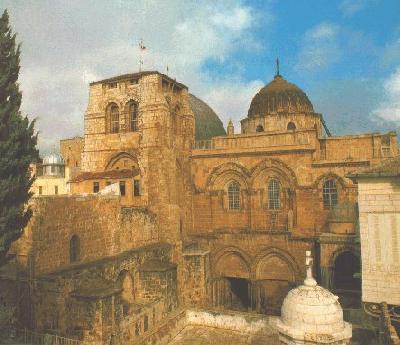 |
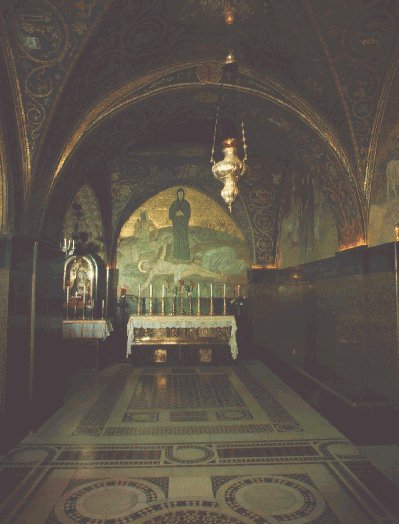 |
 |
 |
 |
 |
Note: Image number will appear in the pop-up line when you will point your mouse on the pictures of Jerusalem. The image number corresponds to the notes number below
186 = The Church of the Holy Sepulcher
187 = The Chapel of Calvary in the Church of the Holy
Sepulcher. In the center is the Alter of our Lady of Sorrows.
The Church of Resurrection
The most holy and historic site for Christians on Earth.
The church stands above Calvary (also known as Golgotha), the place of
the crucifixion and the tomb where the body of Christ was laid. The church
was constructed first in 324 in the time of Emperor Constantine following
the pilgrimage of his mother Helena to the Holy Land. The church built
by Helena was destroyed by the Persians in 614. The place was rebuilt by
Abbot Modestos but it was destroyed again in 1009 by the Khalif Makem.
In 1084 the church was restored by the conquest of Jerusalem.
Today in the Basilica there are six communities with
certain rights under the Law of the Status Quo. The six communities
are (1) the Latins (2) the Greek Orthodox (3) The Armenians (4) The Syrian
'Jacobites"(5) the Coptics and (6) the Abyssinians. The church open daily
from 4:30 am to 8 pm in summer (7 pm in winter).
The main intrance (see picture 186 above) is in the southern courtyard, accessable from Christian Quarter Road or Dabbaga Road of Shuk Khan ez - Zeit. The church is a conglomeration of chapels and alters and Stations of the Cross. Once in the church, the Anointment Stone is the first Holy site you come to. The reddish-brown limestone slab is regarded as the place where the body of Jesus was anointed before he was entombed. Underneath the Golgotha chapel is the Greek Orthodox Chapel of Adam, where a skull was found here, and the claim is that it's the skull of Adam.
188 = The Rock of Anointing and eight lamps above
it. The rock is a piece of polished red rock 5,70 m in length, 1.30 m in
width, and 30 cm in height, it stands on the entrance of the Basilica where
once stood an oratory of the anointing of the lifeless body of Christ by
Nicodemus.
The Stone of Unction
Above the Chapel of Adam is Golgotha Rock or Calvary.
The Calvary
It is a large rock rising out of the ground, called also
Golgotha (In Hebrew) or Calvaria (Latin) meaning the place of the skull.
The argument in Byzantine times ran that the name was given to the rock
because Adam was buried here, but some scholars nowadays figure the most
likely interpretation is that Golgotha was a skull-shaped hill outside
the walls of Jerusalem (see Ancient Jerusalem map at the
map page) which was used as a place of execution and burial. By the
definition, both the Holy Sepulchre and the Garden Tomb (at East Jerusalem,
see right picture above and
next Jerusalem tour
page) fit the specification.
Today there are two chapels at the top of the Calvary, one belongs to the Greek Orthodox, and it is believed to be the site of the Crucifixion. The second where Jesus was stripped of his garments and nailed to the cross and belongs to the Roman Catholics.
And when they were come to the place, which is called Calvary (The skull) there they crucified him and the malefactors, one on the right hand, and the other on the left ( Luke 23: 33 ).
189 right = Calvary - Altar of the Cross - Twelfth
( XII ) Station.
189 left = Calvary - Altar of the Crucifixion -
Eleventh
( XI ) Station.
 |
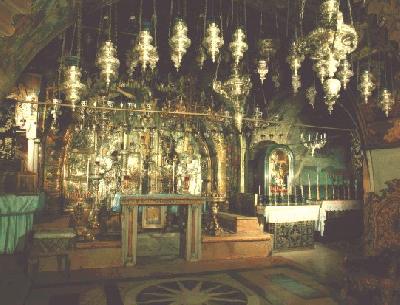 |
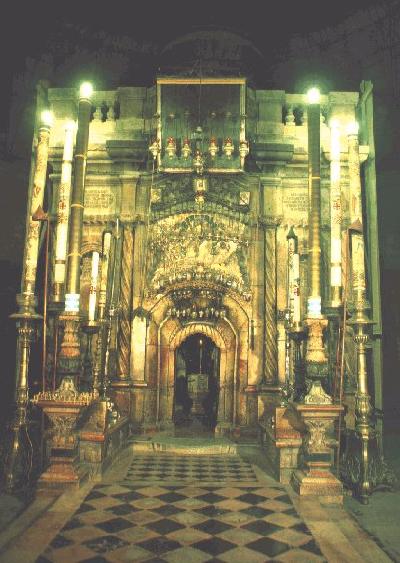 |
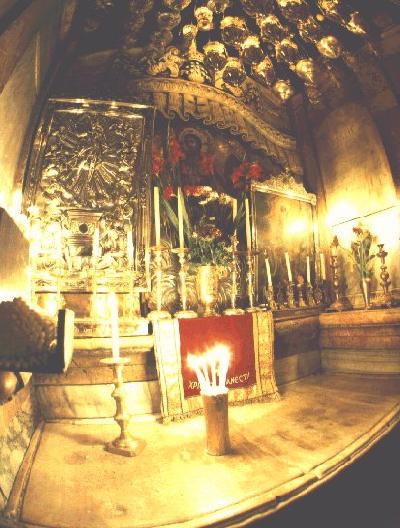 |
Note: Image number will appear in the pop-up line when you will point your mouse on the pictures of Jerusalem. The image number corresponds to the notes number below
190 = The Tomb - The Holy Sepulcher
The Holy Sepulcher
This is the primary focus of faith and candle-lit glow.
The portico of the chamber is called the Angel
Chapel because tradition has it that the angels were sitting
here when they announced to the women that Christ had risen. The body of
Jesus lay in the burial chamber on the bench now faced in marble. Today
the tomb is all of the last century. It has a narrow entrance, 1.33 m high
the entrance leads to the Holy Sepulcher which is 2.70 m in length, 1.93
m in width. The burial place is marked by a marble stone. The original
rock is hidden beneath the marble covering.
191 = The Tomb of the Holy Sepulcher - Interior
Other sites at the Church of the Holy Sepulcher:
Behind the Holy Sepulcher is the Chapel of the Copts, which boasts a part of the Rock tomb which can be seen (and kissed) at the alter in back. To the right of the Sepulcher is the Chapel of Mary Magdalene, celebrating where she, along with two others, discovered the empty tomb on Easter morning. She is also believed to be the first to have seen the Risen Christ. Some of many other chapels to wander through include: The Chapel of the Appearance, where Jesus appeared to his mother; the Prison of Christ, where Jesus and other criminals were supposedly held prisoner; the Seven Arches of the Virgin Mary, the Crypt of the Invention of the Cross, where Helena is said to have found the cross Jesus died on.
Drs.Koudinov Office
|| Drs.Koudinov Holy Land || step
back || continue the tour || Jerusalem
and Holy Land maps
To stop audio press STOP button on the Internet Explorer toolbar